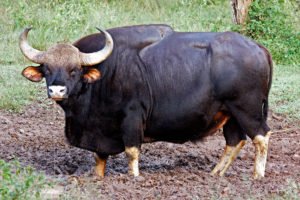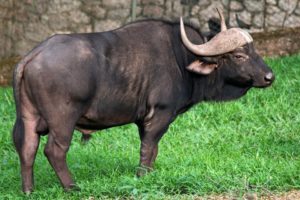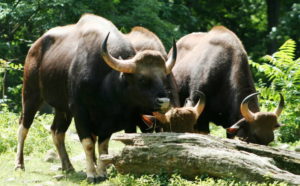The gaur, which is also called the Indian bison, is the largest extant bovine native to the Indian Subcontinent and Southeast Asia. It’s the tallest of the wild cattle species. The malayan gaur is called a “seladang,” while the Burmese gaur is called the “pyoung.” Take a look below for 26 more interesting and weird facts about the gaur.
1. There are 3 subspecies of gaur that can be found in Nepal and India, Thailand and Malaysia, and from Myanmar to China. The gaur that’s found in Nepal and India is called the Indian bison; the gaur that’s found in Thailand and Malaysia is called the Malaysian bison; and the gaur that’s found in Myanmar and China is called the South East Asian Bison.
2. They inhabit evergreen and deciduous forests, that are up to 6,000 feet in altitude. However, a massive amount of their habitat has been destroyed recently due to human population growth.
3. Male gaur weigh between 1,400 and 2,200 pounds. They can reach lengths of 8 to 11 feet and heights of 5 to 7 feet, when measured at the shoulder. Female gaur can only reach a quarter of the male’s size.
4. Male and female gaur have upwardly curved horns. Their horns can reach up to 45 inches in length and they’re usually green or yellow in color, with black tips.
5. Their body is covered with a reddish or brownish coat. Female and younger gaur have much lighter coats than males.

6. They’re herbivores, which means that they primarily eat plants. Their diet consists of grass, leaves, shoots and fruit.
7. They have a deep hollow area on their forehead and a ridge that passes between the horns. They have large ears that look very prominent on their massive head.
8. They’re diurnal, which means that they’re active during the day.
9. The gaur are mainly active early in the morning and late in the afternoon. However, in areas close to humans, they can change their normal routine and become nocturnal so that they can avoid human contact.
10. They live in herds that usually have 8 to 11 members; sometimes they can have up to 40 members.
11. Groups consist of one dominant male and female. They live in a matriarchate, which means that the group is led by a female leaders.
12. Since they’re so big and strong, they don’t have many predators. Tigers and crocodiles are their main predators, but they usually successfully defend against them. Apart from them, humans sometimes hunt the gaur for a variety of reasons, but they have a protected status now.
13. During the dry season, the gaur will live in small groups and will reside on smaller altitudes.
14. During monsoon season, they will gather in large groups and move towards the hills.

15. They are territorial animals and one group will require a territory of around 30 square miles.
16. They produce a variety of sounds for communication. They make high pitched growls when they need to warn the group about potential danger. They make roaring sounds during mating season to try and attract female gaur.
17. They’re known for their bad temper. Even when they’re unprovoked, they can attack and inflict deadly injuries with their horns.
18. They mate from December to June. Dominance between the males is determined by their size. The biggest male gets the opportunity to make with all of the females in one group.
19. The female will remain pregnant for 275 days and the pregnancy will end with one baby, which is called a “calf.”
20. They can live up to 30 years in captivity.
21. An average gaur calf will weigh about 23 kilograms, or 50 pounds.

22. Gaur calf are weaned until they’re about 9 months old.
23. The gaur become sexually mature when they’re 2 to 3 years old. Female gaur have a 12 to 15 month interval between they give birth again.
24. Male gaur are known to form bachelor herds, or in some cases, older bulls may become solitary.
25. The gaur is the State Animal of Goa in India.
26. The Red Gaurs were an extreme right-wing paramilitary organization that was active in Thailand during the 1970s.




